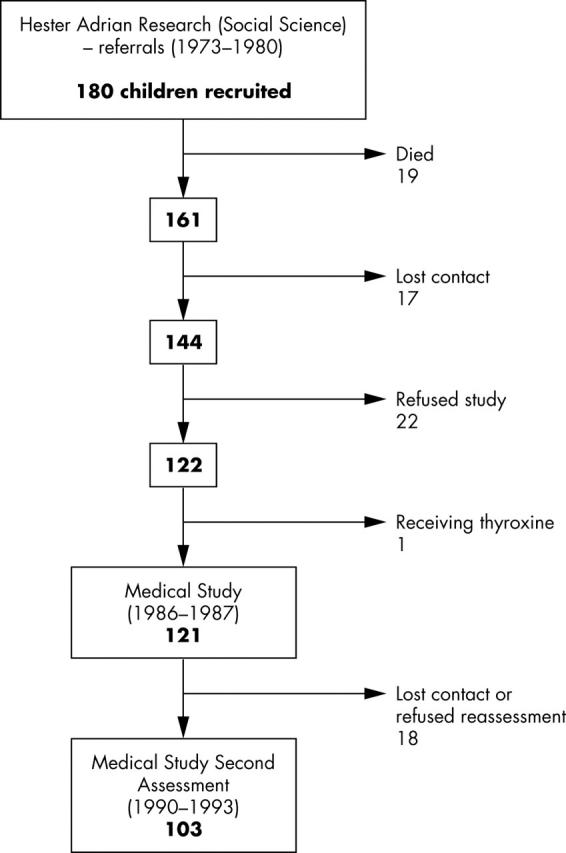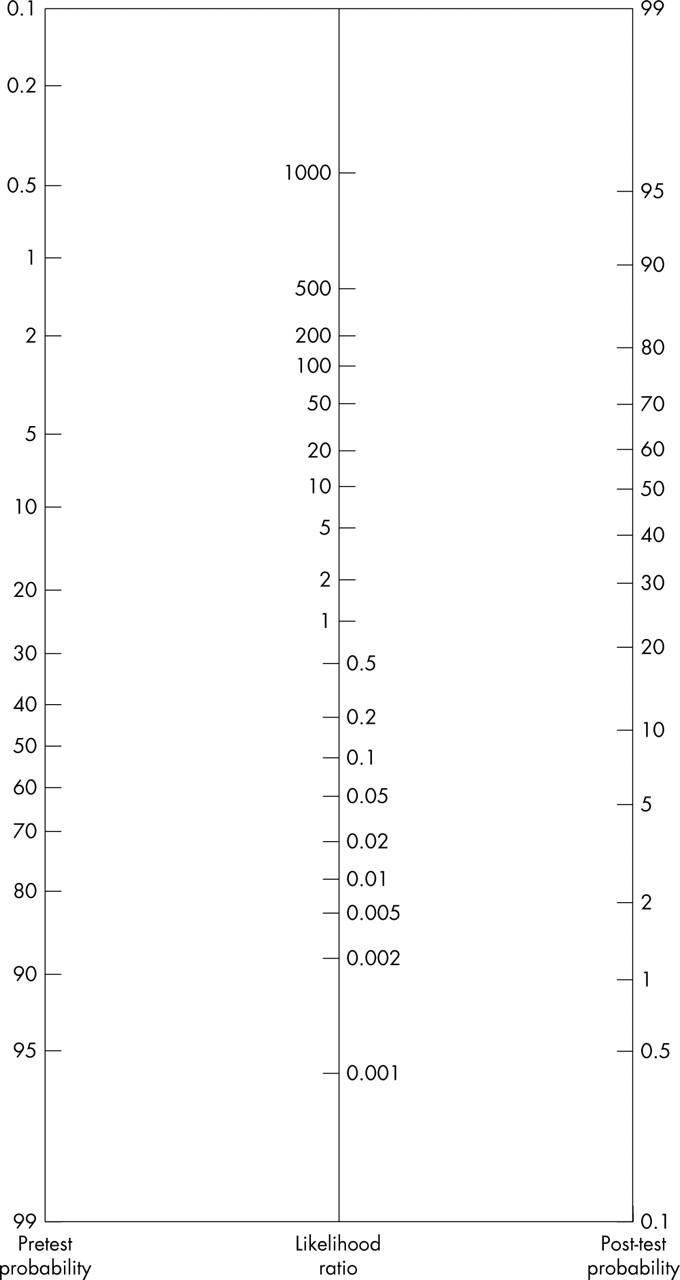Abstract
Aims and Methods: Thyroid function tests were initially carried out on 122 children with Down's syndrome aged 6–14 years and then repeated four to six years later in 103 adolescents (85% of the group of 122) when they were aged 10–20 years (median 14.4 years). At the second test two were hypothyroid and two with isolated raised thyroid stimulating hormone (IR-TSH) were receiving thyroxine.
Results: At the first test there were 98 (80%) euthyroid children: 83 were retested and four (5%) had IR-TSH. At the first test 24 had IR-TSH: 20 were retested and 14 (70%) had become normal. Seventeen with IR-TSH on initial testing had a thyrotrophin releasing hormone test within three months; TSH had become normal in eight (47%) of these children. There was no association between reported clinical symptoms and IR-TSH, but there were clear symptoms in one of the two with definite hypothyroidism.
Conclusions: The likelihood ratio for a positive result on second testing when raised TSH and positive antibody status on first testing are combined is 20. This suggests initial testing results could be used as a basis to select a subgroup for further testing at say five yearly intervals unless new symptoms emerge in the interim. It also suggests that yearly screening (as recommended by the American Academy of Pediatrics, 2001) is probably not justified in the first 20 years of life.
Full Text
The Full Text of this article is available as a PDF (76.1 KB).
Figure 1.

Study population.
Figure 2.

Fagan's likelihood rationomogram.18 Known population pre-test probabilities set against likelihood ratios derived for a given test set against the nomogram allow the prediction an individual's probability of a future abnormal result. Adapted from Fagan TJ (N Engl J Med 1975;293:257). Copyright 1975, New England Journal of Medicine. All rights reserved.
Selected References
These references are in PubMed. This may not be the complete list of references from this article.
- Fagan T. J. Letter: Nomogram for Bayes theorem. N Engl J Med. 1975 Jul 31;293(5):257–257. doi: 10.1056/NEJM197507312930513. [DOI] [PubMed] [Google Scholar]
- Fort P., Lifshitz F., Bellisario R., Davis J., Lanes R., Pugliese M., Richman R., Post E. M., David R. Abnormalities of thyroid function in infants with Down syndrome. J Pediatr. 1984 Apr;104(4):545–549. doi: 10.1016/s0022-3476(84)80544-2. [DOI] [PubMed] [Google Scholar]
- Gruñeiro de Papendieck Laura, Chiesa A., Bastida M. G., Alonso G., Finkielstain G., Heinrich J. J. Thyroid dysfunction and high thyroid stimulating hormone levels in children with Down's syndrome. J Pediatr Endocrinol Metab. 2002 Nov-Dec;15(9):1543–1548. doi: 10.1515/jpem.2002.15.9.1543. [DOI] [PubMed] [Google Scholar]
- Hunter I., Greene S. A., MacDonald T. M., Morris A. D. Prevalence and aetiology of hypothyroidism in the young. Arch Dis Child. 2000 Sep;83(3):207–210. doi: 10.1136/adc.83.3.207. [DOI] [PMC free article] [PubMed] [Google Scholar]
- Ivarsson S. A., Ericsson U. B., Gustafsson J., Forslund M., Vegfors P., Annerén G. The impact of thyroid autoimmunity in children and adolescents with Down syndrome. Acta Paediatr. 1997 Oct;86(10):1065–1067. doi: 10.1111/j.1651-2227.1997.tb14808.x. [DOI] [PubMed] [Google Scholar]
- Karlsson B., Gustafsson J., Hedov G., Ivarsson S. A., Annerén G. Thyroid dysfunction in Down's syndrome: relation to age and thyroid autoimmunity. Arch Dis Child. 1998 Sep;79(3):242–245. doi: 10.1136/adc.79.3.242. [DOI] [PMC free article] [PubMed] [Google Scholar]
- McAloon J., Corrigan N. Controversy in thyroid disease. J R Coll Physicians Lond. 2000 Nov-Dec;34(6):587–587. [PubMed] [Google Scholar]
- Noble S. E., Leyland K., Findlay C. A., Clark C. E., Redfern J., Mackenzie J. M., Girdwood R. W., Donaldson M. D. School based screening for hypothyroidism in Down's syndrome by dried blood spot TSH measurement. Arch Dis Child. 2000 Jan;82(1):27–31. doi: 10.1136/adc.82.1.27. [DOI] [PMC free article] [PubMed] [Google Scholar]
- Posner E. B., Colver A. F. Thyroid dysfunction in Down's syndrome: relation to age and thyroid autoimmunity. Arch Dis Child. 1999 Sep;81(3):283–283. doi: 10.1136/adc.81.3.278o. [DOI] [PMC free article] [PubMed] [Google Scholar]
- Pueschel S. M., Jackson I. M., Giesswein P., Dean M. K., Pezzullo J. C. Thyroid function in Down syndrome. Res Dev Disabil. 1991;12(3):287–296. doi: 10.1016/0891-4222(91)90013-i. [DOI] [PubMed] [Google Scholar]
- Pueschel S. M., Pezzullo J. C. Thyroid dysfunction in Down syndrome. Am J Dis Child. 1985 Jun;139(6):636–639. doi: 10.1001/archpedi.1985.02140080106045. [DOI] [PubMed] [Google Scholar]
- Rooney S., Walsh E. Prevalence of abnormal thyroid function tests in a Down's syndrome population. Ir J Med Sci. 1997 Apr-Jun;166(2):80–82. doi: 10.1007/BF02944192. [DOI] [PubMed] [Google Scholar]
- Rubello D., Pozzan G. B., Casara D., Girelli M. E., Boccato S., Rigon F., Baccichetti C., Piccolo M., Betterle C., Busnardo B. Natural course of subclinical hypothyroidism in Down's syndrome: prospective study results and therapeutic considerations. J Endocrinol Invest. 1995 Jan;18(1):35–40. doi: 10.1007/BF03349694. [DOI] [PubMed] [Google Scholar]
- Selby K. A., Newton R. W., Gupta S., Hunt L. Clinical predictors and radiological reliability in atlantoaxial subluxation in Down's syndrome. Arch Dis Child. 1991 Jul;66(7):876–878. doi: 10.1136/adc.66.7.876. [DOI] [PMC free article] [PubMed] [Google Scholar]
- Selikowitz M. A five-year longitudinal study of thyroid function in children with Down syndrome. Dev Med Child Neurol. 1993 May;35(5):396–401. doi: 10.1111/j.1469-8749.1993.tb11660.x. [DOI] [PubMed] [Google Scholar]
- Toledo C., Alembik Y., Dott B., Finck S., Stoll C. Anomalies du fonctionnement thyroïdien des enfants trisomiques 21. Arch Pediatr. 1997 Feb;4(2):116–120. doi: 10.1016/s0929-693x(97)86151-9. [DOI] [PubMed] [Google Scholar]
- Toscano E., Pacileo G., Limongelli G., Verrengia M., Di Mita O., Di Maio S., Salerno M., Del Giudice E., Caniello B., Calabrò R. Subclinical hypothyroidism and Down's syndrome; studies on myocardial structure and function. Arch Dis Child. 2003 Nov;88(11):1005–1008. doi: 10.1136/adc.88.11.1005. [DOI] [PMC free article] [PubMed] [Google Scholar]
- Tüysüz B., Beker D. B. Thyroid dysfunction in children with Down's syndrome. Acta Paediatr. 2001 Dec;90(12):1389–1393. doi: 10.1080/08035250152708770. [DOI] [PubMed] [Google Scholar]
- Varadkar S., Bineham G., Lessing D. Thyroid screening in Down's syndrome: current patterns in the UK. Arch Dis Child. 2003 Jul;88(7):647–647. doi: 10.1136/adc.88.7.647. [DOI] [PMC free article] [PubMed] [Google Scholar]
- van Trotsenburg A. S. P., Vulsma T., van Santen H. M., Cheung W., de Vijlder J. J. M. Lower neonatal screening thyroxine concentrations in down syndrome newborns. J Clin Endocrinol Metab. 2003 Apr;88(4):1512–1515. doi: 10.1210/jc.2002-021303. [DOI] [PubMed] [Google Scholar]


